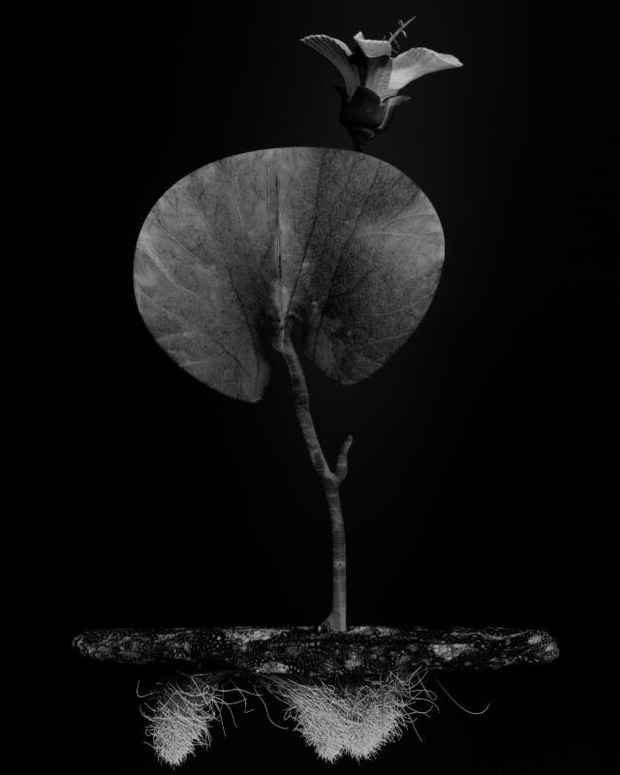Miljohn Ruperto & Ulrik Heltoft “Voynich Botanical Studies”
Koenig & Clinton

[Image: Miljohn Ruperto & Ulrik Heltoft "Voynich Botanical Studies, Specimen 02v Leto" (2017) silver gelatin print on fiber-based paper, Sheet: 19 3/4 x 15 3/4 in. Frame: 25 1/4 x 21 1/4 in.]
This event has ended.
Koenig & Clinton presents the gallery’s first exhibition dedicated to Miljohn Ruperto & Ulrik Heltoft’s ongoing series, Voynich Botanical Studies. Carefully rendered by Ruperto and then manually printed by Heltoft, the otherworldly images of twenty unique ‘specimens’ have been inspired by the original Voynich Manuscript. This exhibition brings together the largest gathering of ‘specimens’ ever on view since the project commenced in 2013.
“The strangeness and mystery of the Voynich Manuscript has inspired musicians and novelists. Not surprisingly, the document has also proved a springboard for visual artists, but the remarkable thing about the body of work made by Miljohn Ruperto and Ulrik Heltoft is how it doesn’t just feed off the manuscript’s secrets and complications but builds upon them to become something odd, fantastic and mysterious in its own right.
The Voynich Manuscript, in the collection of the Beinecke Library at Yale, dates from the 15th or 16th century. At least the vellum does. Everything else about the modest-sized, 240-page volume is in dispute: its country of origin (though scholars narrow it down to Central Europe); the undecipherable language of its text (possibly a code?); the purpose—scientific? artistic? both?—of its botanical, astronomical, astrological, and biological illustrations. Some claim the manuscript is a hoax. Some say it was written by aliens. Some attribute curative powers to the pages and have attempted to lick or consume them.
Ruperto, based in L.A., and Heltoft, from Copenhagen, have produced a series of photographs based on the manuscript’s 100+ ink and colored wash botanical illustrations, which detail unidentifiable plant species. Using computer imaging software, they construct three-dimensional visualizations of the individual plants, make a negative from each digital file, and then silver gelatin prints, the traditional way, in the darkroom.
The images are stunning, surprising, curious. Each plant specimen, isolated against a rich black ground, reads as a sculptural presence with palpable texture—thistled, shriveled, silky, rugged, rubbery, glossy. One of them has two stems that dangle bell-like pods and a crown of tiny pineapples, this sweetly ornamental array rising from a thick, hairy rod of roots surging with raw sexuality. Another crazy beauty mashes together a trio of whiskered lotus seed heads, a chandelier of sinuous stems barnacled with dark beads, and a drooping mass of vaguely animate ridged pods.
The pictures pay homage to Karl Blossfeldt’s elegant taxonomic studies of the 1920s, published as ‘Urformen der Kunst’ (Art Forms in Nature), and also recall Joan Fontcuberta’s witty and whimsical ‘Herbarium’ photographs of the early 1980s, documenting hybrid flora of the artist’s own devising.
Whatever the motivations behind the original Voynich illustrations, Ruperto and Heltoft’s pictures manifest a delicious paradox as photographic records of imaginary subjects, indexical traces of fictions. Their integration of analog and digital photo technologies further complicates the temporal weave upon which these images float: old yet new; hand-crafted but electronically-generated; historically grounded and also ephemerally ageless. Steeped in contradiction, they supply crisp evidence of a gauzy, existential indeterminacy. They are perfect relics of photography’s 21st-century era of exploration.”
-Leah Ollman
A version of this text first appeared in the Los Angeles Times, 17 May 2013
Miljohn Ruperto (b. 1971 Manila, the Philippines) received his M.F.A. from Yale University in 2002 and his B.A., studio art from University of California, Berkeley in 1999. Ruperto has exhibited his work internationally at numerous venues, including: Geomancies, at REDCAT Gallery, Los Angeles (2017); What We Know that We Don’t Know, Kadist, San Francisco (2017); Afterwork, ILHAM Gallery, Kuala Lumpur (2016) and Para-Site, Hong Kong (2016); Nervous Systems, Haus der Kulturen der Welt, Berlin (2016); The As-if Principle, Magazin4 Bregenzer Kunstverein, Austria (2015); 2014 Whitney Biennial, Whitney Museum of American Art, New York; Janus, Dunlop Art Gallery, Regina Public Library, Saskatchewan, Canada; Made in L.A., Hammer Museum. Ruperto lives and works in Los Angeles.
Ulrik Heltoft (b. 1973 Svendborg, Denmark) received his M.F.A. in sculpture from Yale University in 2001 and studied at The Royal Danish Academy of Fine Arts in Copenhagen. His work has been the subject of solo exhibitions at Secession, Vienna; Aarhus Center for Contemporary Art, Denmark; Raucci Santamaria, Naples; Willfried Lentz Gallery, Rotterdam; Andersen´s Contemporary, Copenhagen; Kirkhoff, Copenhagen; and CPH Kunsthal, Copenhagen. Heltoft’s work has been featured in notable group exhibitions at: Whitechapel Project Space, London; Magazin4 Bregenzer Kunstverein, Austria; Whitney Museum for American Art, New York; Museum Kunst der Westküste, Alhersum/Föhr; The Museum of Contemporary Art, Antwerp; New Museum, New York; Murray Guy, New York; Binz39, Zürich; and participant inc, New York. Heltoft is currently an associate professor at The Royal Danish Academy of Fine Arts, Laboratory for Photography. The artist lives and works in Copenhagen, Denmark.
Media
Schedule
from September 09, 2017 to October 22, 2017
Opening Reception on 2017-09-15 from 18:00 to 20:00